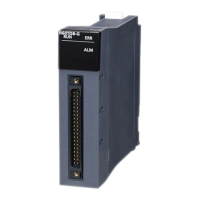304
15 QnACPU DEDICATED COMMANDS
15.3 File Control
File No. usage
A data that shows the usage status of the file No. for 256 files to be returned to external devices when the usage status of file
No. is read.
■Data communication in ASCII code
Convert the numerical value to 64-digit ASCII code (hexadecimal) and send it to the external device side. (File No. for 8 files:
2 digits)
■Data communication in binary code
Send the following 32-byte value which indicate the usage status to the external device side from the lower bytes (L: bits 0 to
7). (File No. for 8 files: 1 byte)
■Content of file No. usage
The usage status of each file No. is indicated as one file number per bit.
File No. usage
0: Not used, 1: Used
*1 Usage of file No. 8
*2 Usage of file No. 1
*3 Usage of file No. 256
The contents of file No. usage to be returned to external devices under the conditions above are shown below.
• Data communication in ASCII code: 'D3B97A' ... 'FFFF' are returned, and are sequentially send beginning from the 'D'.
• Data communication in binary code: 'D3H', 'B9H', '7AH' ... 'FFH', 'FFH' are returned, and sequentially send beginning from
'D3H'.
File lock mode
A data to specify whether or not a locked file is forcefully unlocked in order to allow access to the specified file from other
devices.
■Data communication in ASCII code
Convert the numerical value to 4-digit ASCII code (hexadecimal), and send it from the upper digits.
■Data communication in binary code
Send 2-byte numerical value from the low byte (L: bits 0 to 7).
■Specified value and contents of the file lock mode (Other values cannot be specified.)
■Unlock method for locked file
There are two methods for locking files:
Bit string b7 b6 b5 b4 b3 b2 b1 b0 Values for 8 bits
1st byte 1
*1
1010011
*2
D3H
2nd byte10111001B9H
3rd byte011110107AH
4th byte1001011096H
5th byte0111000171H
31st byte00000000FFH
32nd byte 0
*3
0000000FFH
Specified value Content to be specified
0000H Unlock the locked file normally.
0002H Unlock the locked file forcefully.
Method Description
Normal
execution
The locked file cannot be unlocked when other device has registered the file lock.
When the file lock deregistration is requested, an error occurs and an abnormal response is returned.
Forced
execution
The locked file is forcefully unlocked even if other device has registered the file lock.
Use the forced execution function when a locked file cannot be unlocked because of problems in the device that registered the file lock.

